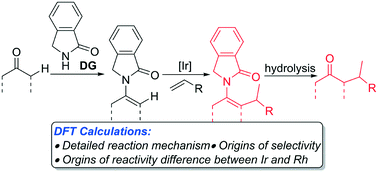Mechanism, selectivity, and reactivity of iridium- and rhodium-catalyzed intermolecular ketone α-alkylation with unactivated olefins via an enamide directing strategy†
Abstract
Density functional theory calculations were performed to investigate the iridium- and rhodium-catalyzed intermolecular ketone α-alkylation with unactivated olefins via an enamide directing strategy. The computations show that after the initial C–H oxidative addition, the Ir system proceeds through the pathway of the migratory insertion into the Ir–C bond/C–H reductive elimination. The calculations reproduced quite well the experimentally observed regio- and chemoselectivities. The regioselectivity of the reaction was found to be caused by a combination of both steric and electronic effects, which makes the 2,1-insertion into the Ir–C bond much more favored than the 1,2-insertion into the Ir–C bond, resulting in the observed excellent branched selectivity. The chemoselectivity of the reaction taking place exclusively with the alkene C(sp2)–H bond can be explained by the fact that the aromatic C(sp2)–H oxidative addition to form five- and seven-membered metallacycles suffers from higher strain energy than the alkene C(sp2)–H oxidative addition to form a six-membered metallacycle. The replacement of Ir by Rh turns out to have a profound impact on the energies of the elementary steps, which not only makes the catalytic activity of the Rh catalyst much less efficient compared to the Ir catalyst, but also results in the mechanistic change to an alternative pathway via the migratory insertion into the Rh–H bond/C–C reductive elimination to produce the linear product.



 Please wait while we load your content...
Please wait while we load your content...